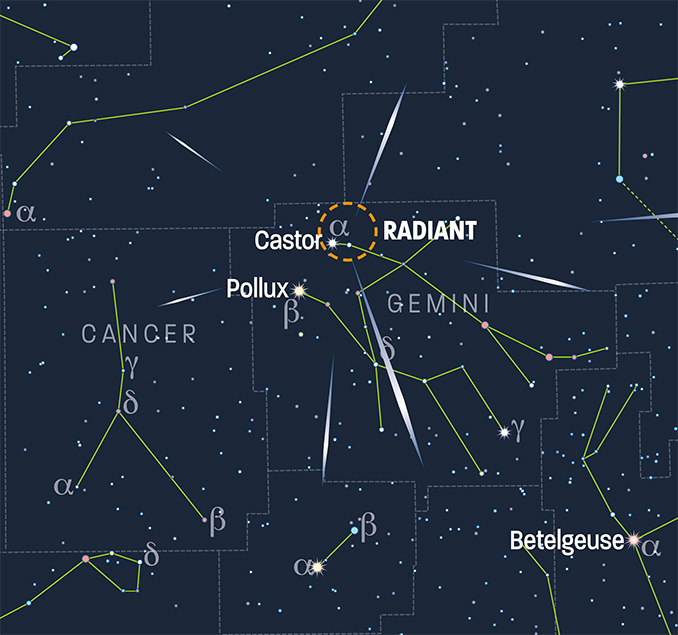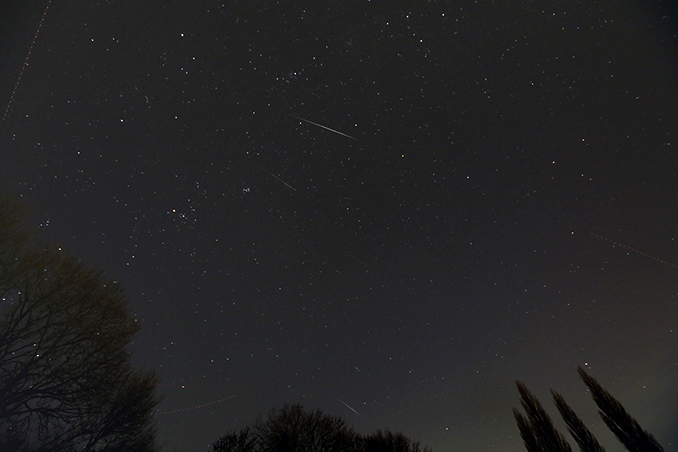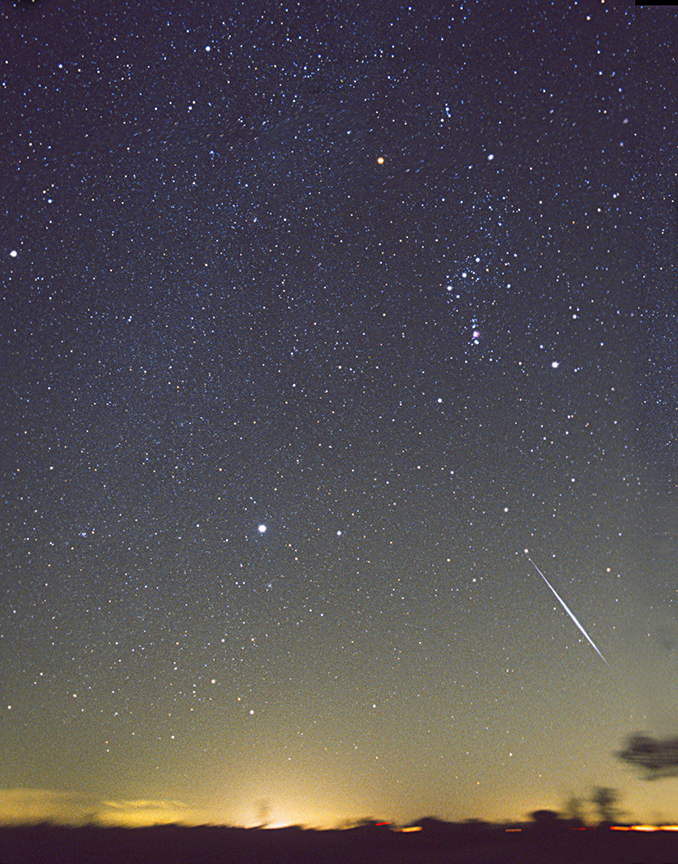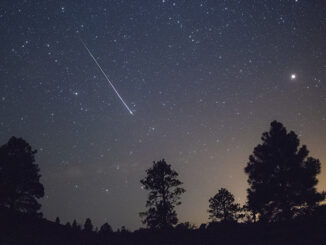
Watch out tonight (13th/14th) and tomorrow night (14th/15th) for the welcome return of the Geminid meteor shower, now widely regarded as the best and most reliable of the annual meteor showers. Given a clear and transparent sky at a site free from major light pollution you could be treated to a great show of a few dozen shooting stars an hour, despite major glow from a waning gibbous Moon (at last quarter is on 16 December).
The Geminids come to a broad peak on 14 December. Depending on which source of information one taps, this peak is timed for between about 01h to 13h UT. Over recent decades, the Geminids have reached maximum activity between 21h UT on 13 December to 18h UT on 14 December.
Watches on the nights of 13/14 and 14/15 are likely both to be fruitful from late evening onwards. The Geminids radiant (the point in the sky from which the meteors appear to emanate when tracing back their paths) lies close to the bright star Castor (alpha Geminorum; magnitude +1.6) in Gemini, the fainter and more northerly of Gemini’s twins (the other twin being the star Pollux). By 10pm GMT, the radiant has climbed to lie 40° high due east. The Moon rises in western Leo at 8.45pm on 13 December and exhibits a 73 per cent-illuminated gibbous phase. On the following night, 14/15 December, it rises at 10pm, lying further east in Leo.
The Geminids are famous for producing a good proportion of bright, multicoloured events, owing to their being quite robust, entering Earth’s atmosphere at a relatively slow 35 kilometres per second. They often produce persistent trails (or trains) that can fragment. The shower’s debris stream is different from other meteor showers as its debris is not shed by a comet but rather by an asteroid, namely (3200) Phaethon.

Rock-comet Phaethon: source of the Geminids
For most of the twentieth century, astronomers puzzled over the source of the Geminid meteor shower. Then in 1983 the American astronomer Fred Whipple realised that an object (initially designated 1983 TB) that was discovered while searching data from NASA’s Infrared Astronomical Satellite (IRAS) had an orbit coincident with that of the Geminid meteors. Astronomers believed at last they had found the long-sought-after parent body of the Geminids. It was subsequently numbered and named (3200) Phaethon (after Phaethon, the son of the sun god Helios).
Meteor showers are known to be spawned by periodic comets; they shed minute debris on their repeated visits to the inner Solar System, which spreads out along their orbit. When Earth encounter this stream, a meteor shower occurs. However, Phaethon has an usually eccentric orbit, with a period of just 1.4 years and a perihelion distance of just 0.14 astronomical unit (less than half that of Mercury). Furthermore, for decades it has revealed no evidence for major mass-loss or any comet-like activity. So how did the Geminids healthy debris stream originate?
A breakthrough came in 2009, when NASA’s STEREO-A spacecraft imaged Phaethon near perihelion (closest to the Sun). Unexpected brightening, by a factor of two, was seen and put down to dust particles being seared away from Phaethon’s Sun-baked surface. Subsequent observations also detected a dust tail. The term ‘rock comet’ was suggested for Phaethon. One of the astronomers who led the 2009 investigating team, David Jewitt from UCLA in Los Angeles, California, describes a rock comet as “essentially, an asteroid that comes very close to the Sun – so close that solar heating scorches dusty debris right off its rocky surface”.
Astronomers soon realised though that the amount of dust ejected was way off that needed to keep the Geminid stream topped-up in order to produce activity seen. It’s now thought possible some disruptive event in the past few thousand years provided the debris.
(3200) Phaethon is a 5.8-kilometre (3.6 mile)-wide Apollo asteroid (a group of near-Earth asteroids named for (1862) Apollo) that’s termed a ‘rock comet’. This is essentially an asteroid which comes unusually close to the Sun, with the resultant solar scorching striping off copious amounts of robust grains. (3200) Phaethon approaches the Sun closer than any other named asteroid. As an Earth-crossing asteroid it is termed as a potentially hazardous asteroid (PHA), though there is no threat to Earth for the foreseeable future.

Top tips for Geminid spotting
- Dress appropriately for cold weather by wearing plenty of layers of warm clothing, with a warm hat and a pair of gloves.
- Bring along a hot drink and a couple of snacks to keep you going. Avoid alcohol until a well-deserved nip of something amber at the end of the watch!
- Get comfortably sitting on a deckchair or in a reclining chair to maximise alertness.
- Find an observing site (a rural one if you can) from where the sky at an altitude of 50 degrees from the horizon may be watched.
- Such a site should be away from or shielded as far as possible from direct sources of light pollution.
- Make sure you become fully dark adapted (for at least 15–20 minutes) before starting a watch and use only a red torch for illumination.
- Rather than peering intently directly at the radiant, look some 30 or 40 degrees away, where the meteors will appear brighter.
- Orion and Taurus are fertile areas to the west, with Cancer and Leo to the east.
- Take regular breaks and avoid marathon sessions; perhaps limit a watch to two-hour stints if you intend to observe all night.



